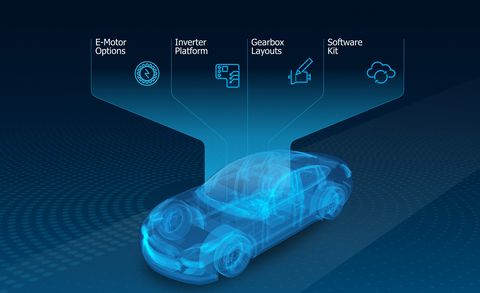- The auto industry needs so many electric motors right now that the backlog is worth almost $26 billion, according to supplier ZF.
- To help fill the need, ZF this week announced details of its next-generation electric motor, power electronics, transmission, and control software.
- The new system is lighter and smaller than the current system and requires around 10 percent fewer raw materials to build, including barely any rare earth metals.
Evolving and improving mechanical devices in an automobile has long been focused on the internal-combustion engine. With the slow shift to electric powertrains underway, it shouldn’t be a surprise that the industry is refocusing engineering talent on making next-generation electric motors more efficient. That’s just what ZF announced this week it has done.
Actually, ZF said it made not just the motor but the overall system, or what it calls e-drive, more efficient. That also required improving the power electronics, the transmission, and the control software. ZF will offer its new e-drive systems to automakers as a modular system starting from one of three basic configurations beginning in 2025. The individual components will be available sooner. ZF said in its announcement that there is a backlog of electric motors and their related powertrain components worth almost $26 billion.
Lighter, Smaller, More Powerful
That kind of business potential prompted ZF to rework some basic ideas in its current e-drive offerings. A new coaxial reduction gearbox uses two integrated planetary gears to generate the desired axle ratio while also acting as an integrated differential. ZF said its new e-drives would be suitable for use in both passenger and commercial vehicles. One reason for that is that the continuous power of the electric motor has been increased to up to 85 percent of the peak power. Despite all these improvements, the new e-drives are lighter, smaller, and do not compromise on efficiency, noise, or vibration, ZF said.
Physical improvements to the system include new cooling and winding methods on the motor. A unique braided winding ZF developed is a modified hairpin-style approach that’s both more compact and has far fewer welding points. The smaller size helps reduce the size of the motor by around 10 percent, which comes with a similar reduction in the amount of raw materials required. The new slot cooling system that sends oil directly around the copper windings also reduces the amount of heavy rare earth elements needed, down to such a small amount that it can be “largely dispensed with,” ZF said.
ZF offers motors in a wide range of outputs and configurations, operating at either 400 or 800 volts, permanent-magnet synchronous or asynchronous, and with power outputs that range from 67 to 738 horsepower.
On the electronics and software side, ZF has developed new high-voltage DC-DC converters for EVs powered by a hydrogen fuel-cell system. ZF is also introducing “discrete package technology” to its power electronics system because it requires fewer types of components than conventional power modules.
This content is imported from OpenWeb. You may be able to find the same content in another format, or you may be able to find more information, at their web site.






More Stories
5 Frugal Tips to Use When Buying Your First Motorbike
2022 Acura MDX Type S Review: A Sporty Family SUV
Porsche Supercup extends contract as F1 support series through 2030